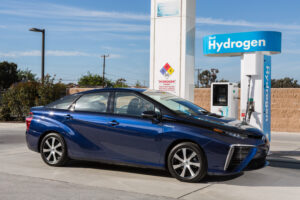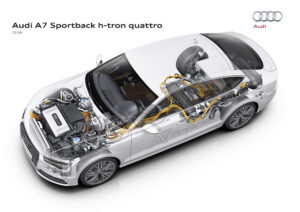Get ready for the hydrogen powered car
- PostedPublished 12 December 2014
HYDROGEN as a fuel is becoming an increasingly serious prospect in the automotive industry, judging by Hyundai’s decision to import a hydrogen-powered ix35 to Australia this month and the number of hydrogen cars displayed at the recent Los Angeles Auto Show.
The annual LA show traditionally has a green theme and this year was no exception with five hydrogen fuel-cell cars on show, including Toyota’s Mirai sedan, which is already hitting Japanese showrooms at the equivalent of $70,000 and will be rolled out in the United States and Europe next year.

Volkswagen Group, which has designs on pinching Toyota’s crown as world’s biggest carmaker, showcased three hydrogen fuel-cell cars in LA – a Golf hatch, a Passat sedan and an Audi A7 coupe – although none will appear in dealerships anytime soon.
Honda, a hydrogen fuel-cell pioneer with its FCX Clarity available for lease in California and Japan since 2008, unveiled a successor to that car that will go on sale in 2016 – along with a unit that enables households to power their homes using the car’s fuel-cell in emergencies.
None of the five LA Show cars are headed Down Under, but Hyundai surprised the world by bringing a fuel-cell ix35 SUV to Australia and installing a refuelling station at its Australian HQ in Sydney last week.
Hyundai claims its hydrogen ix35 is the world’s first series-production fuel-cell car and the Korean carmaker’s Australian arm is using the SUV and refuelling facility as a demonstrator to influence local leaders who have a say in building the infrastructure that will support the introduction of more hydrogen-fuelled vehicles.

Hydrogen fuel-cell vehicles do not burn the gas in a internal-combustion engine but generate electricity in a chemical reaction that mixes hydrogen and oxygen to create water vapour as the only exhaust emission.
Compared with battery electric vehicles that take hours to recharge and have a limited range, production and prototype hydrogen cars tend to have a range of around 600km and take about three minutes to refuel.
For vehicle use, hydrogen is stored at 700 bar (more than 10,000 psi) but those concerned about a road-going Hindenburg disaster should consider that the same manufacturers that have rejected hydrocarbon refrigerants for automotive air conditioning systems are satisfied with the safety of hydrogen fuel systems.
Producing, compressing, storing and transporting hydrogen in the quantities needed for widespread vehicle use – in a sustainable and safe way – are hurdles that need to be overcome, as does building the refuelling infrastructure.

But back when technology was rudimentary compared to what we have now, we built infrastructure that piped natural gas directly into millions of homes and businesses worldwide, not to mention the petrol, diesel and LPG filling stations that keep billions of vehicles around the planet running every day.
A recent breakthrough in ‘artificial leaf’ technology at the University of California could pave the way for large-scale, low-cost hydrogen production by using sunlight to harvest hydrogen from water.
Borrowing methods from the paper industry to ensure the technology can be economically scaled up, researchers created a flat semiconductor mesh from light-absorbing ‘nanowires’ that produces hydrogen gas when immersed in water and exposed to sunlight.
Until artificial leaf technology is refined to the point where it becomes commercially available, the methods for producing hydrogen require a lot of energy – but like recharging a battery electric vehicle, using hydro, solar or wind to create enough power goes toward solving that environmental dilemma.

Hyundai Australia will soon create its own hydrogen on-site with power generated by an array of solar panels and is pushing for the establishment of a local refuelling network, with one proposal that would make it possible to drive between Melbourne, Sydney and Canberra on hydrogen power.
The fuel-cell ix35 is only produced in left-hand drive at the moment but the next-generation model will be available the steering wheel on the right, meaning the vehicle could be available for lease Down Under by 2018.

Some carmakers regard hydrogen as the fuel to see us through the next 50 years, in which time battery technology and recharging infrastructure should have developed enough to make pure electric cars versatile enough to replace the internal combustion engine for good.
Hydrogen is even being touted in Japan as the home energy source of the future, with households making their own electricity from the gas to enable the shutdown of industrial-scale power stations like the tsunami-damaged Fukushima nuclear plant.
VASA members can expect hydrogen cars to start turning up in their workshops, if not by the end of this decade certainly into the 2020s and beyond. Our industry is going through an unprecedented time of technological change – what an exciting time to be part of it.
- CategoriesIn Latest News

